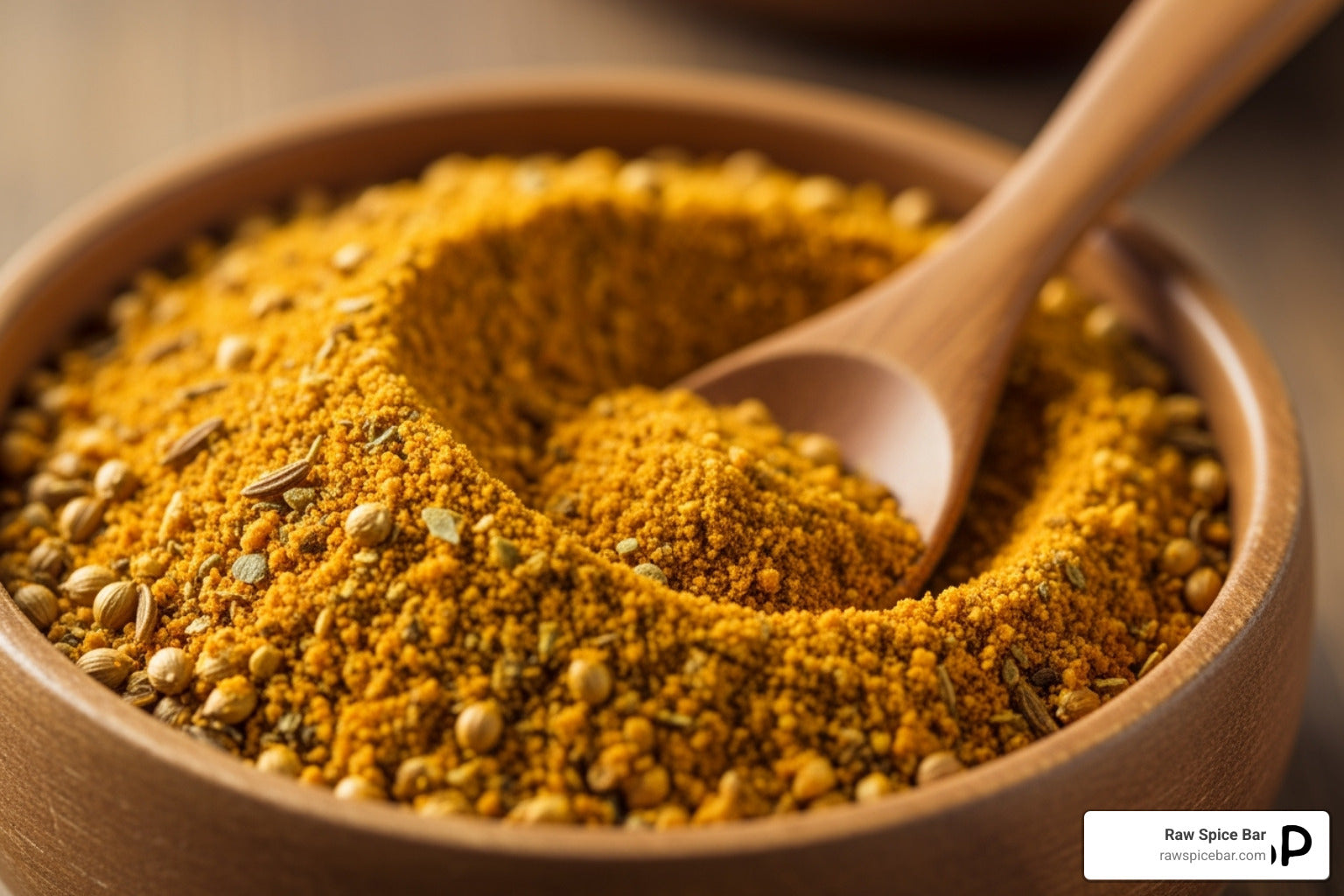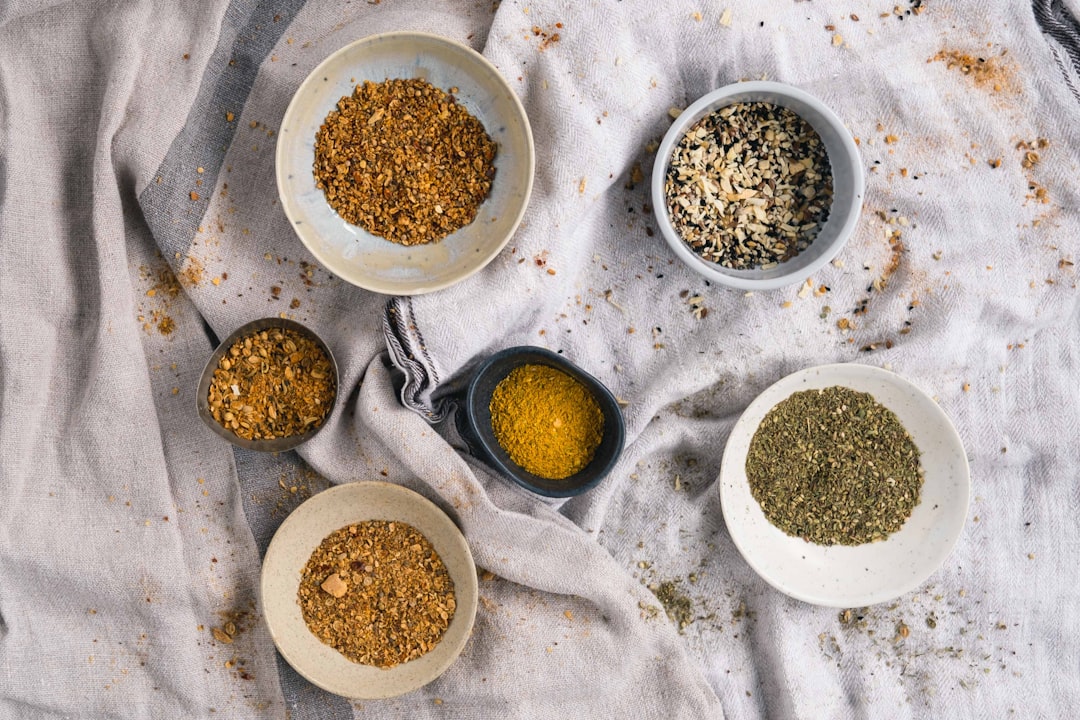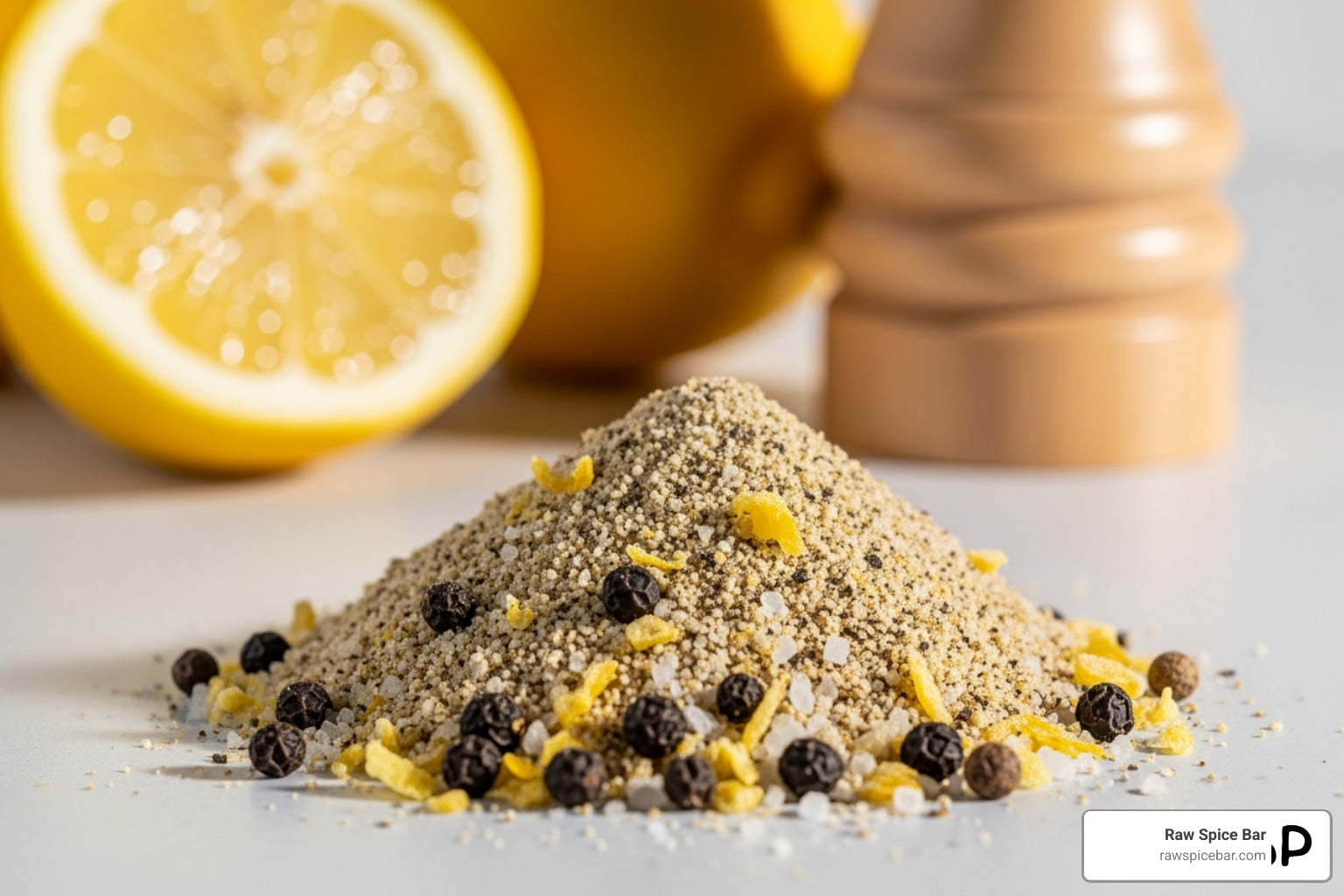Spices have the magical ability to elevate a simple dish into something extraordinary—bringing depth, aroma, and bold flavor that lingers in your senses.
Have you ever noticed how many grocery store spice blends can feel flat and uninspiring?
That’s because spices need to be carefully sourced and used at their peak freshness to deliver their full flavor potential. At Raw Spice Bar, we take pride in crafting spice blends that bring you the vibrant tastes from around the world directly to your kitchen.
Our spice subscription service is your passport to a culinary adventure. By exploring the best spices from various cultures, you unlock an exciting opportunity to enhance your meals effortlessly. Imagine cooking with spices that have been expertly blended and delivered straight to your door, still fresh and full of flavor.
This ensures that every dish you make bursts with authenticity, leaving behind the harshness of salt or preservatives. These superior, globally inspired spice blends are not just ingredients—they’re the key to transforming your cooking.
With Raw Spice Bar, you’re not just making dinner. You’re creating an experience. Each delivery brings new, healthy flavors to your table, allowing you to explore different cuisines and step up your culinary game in no time.
Don’t settle for ordinary when you can cook with extraordinary spices. Join us and taste the difference today.
In this blog, we’ll cover:
-
The rich history of spices and their cultural impact.
-
How sustainable sourcing practices make a difference in spice quality.
-
The complexity and depth spices can bring to your dishes.
Let’s get started!
Historical Significance of Spices
Spices have played an essential role in world history, shaping trade routes and cultural traditions. They have been valued for their aromas, flavors, and potential medicinal properties.
Early Spice Trade
The spice trade has been crucial since ancient times.
Cinnamon, cardamom, and black pepper were highly prized, and their value was often equivalent to gold. Trade routes were established across Asia, the Middle East, and Europe to transport these goods.
Arab merchants initially controlled the spice trade. They traded with the Romans and Greeks and greatly influenced Western culinary traditions. By the Middle Ages, spices symbolized wealth and luxury in Europe.
European explorers, seeking direct access to spice sources, led expeditions to Asia, which helped connect diverse continents and cultures. The desire for spices largely drove the age of exploration and led to advancements in global navigation.
Cultural Impact of Spices
Spices have influenced cultural identities through culinary and medicinal uses.
Each region developed unique dishes incorporating local spices, reflecting its heritage and traditions.
For example, Ethiopian cuisine uses a blend of spices, like berbere, imbuing dishes with deep flavors and historical richness. In France, Herbs de Provence reflects the region’s love for aromatic cooking.
Today, companies like Raw Spice Bar continue this tradition by offering spice blends that make dishes from around the world tasty and exciting. With our subscription, you can enjoy global spices and easy seasonal cooking right at home.
This service brings fresh experiences to your kitchen and celebrates the rich legacy of spices in global cuisine.
Spice Sourcing Principles
Two important principles stand out when sourcing spices for depth, aroma, and flavor: sustainable sourcing and fair trade practices. These ensure the best flavors and ethical and environmentally friendly processes that benefit both producers and consumers.
Sustainably Sourced Spices
Sustainability in spice sourcing means choosing suppliers who prioritize the environment. This involves responsible farming techniques that don’t deplete natural resources. By doing this, soil health is maintained, and biodiversity is protected. Sustainable farming can include crop rotation, organic farming practices, and renewable energy resources.
You benefit from fresher and more aromatic spices. Our team ensures that each spice blend is crafted with whole, natural ingredients. This commitment supports a healthier planet and provides you with high-quality flavors for your cooking.
Fair Trade in the Spice Industry
Fair trade ensures that spice farmers are paid fairly for their labor.
Fair trade supports ethical trade practices, offering better wages and conditions for workers. This helps build sustainable livelihoods and communities. Fair trade also encourages transparency and accountability within the spice industry.
You can enjoy spices with the assurance that growers receive fair compensation. Companies focus on ethical sourcing, providing savory spice blends that tell a global collaboration story. By supporting fair trade, you contribute to positive change in the spice marketplace.
Depth in Spices
Understanding the depth of spices can transform your cooking, bringing out the richest flavors to enhance every dish. Depth involves the complexity of flavors and multidimensional taste profiles that can be achieved through carefully curated spice blends.
Complexity of Flavors
Spices with complex flavors offer a delightful experience that evolves with each bite.
This complexity transforms simple ingredients into culinary masterpieces. For example, the Berbere spice blend from the Horn of Africa is known for its rich, intricate mix, offering a unique taste and aroma.
Our dedication to curating complex blends means you receive only the freshest, flavor-rich spices. Each blend is carefully crafted using vibrant ingredients sourced worldwide, elevating your dishes with every use.
This commitment to complexity ensures each meal you prepare is a new adventure, filled with layers of flavors waiting to be discovered.
Multidimensional Taste Profiles
A multidimensional taste profile means using spices that add more than one flavor note to your dishes. These profiles create a symphony of tastes that linger on your palate. An example is rosemary, which adds woodsy and herbal tones to roasted meats, enhancing their Mediterranean essence rosemary.
Our spice blends are crafted to deliver such multidimensional profiles. By subscribing to their global spice subscription, you introduce a world of sensations into your cooking.
Each blend reaches you within 60 days of hand-blending, ensuring the freshest flavors that create depth and complexity, transforming every meal into an exotic experience.
The Aroma of Spices
The aroma of spices plays a crucial role in transforming ordinary recipes into delightful experiences. These scents not only heighten the taste but also create memorable connections. In this section, you will explore the fascinating aspects of spice aromas.
Scent Analysis
Spices contain volatile oils that are responsible for their distinct aromas.
When these oils are released, often through grinding or heating, they activate your sense of smell. This triggers an emotional and sensory reaction that enhances the entire culinary experience.
For instance, lemon zest provides a bright, citrusy aroma that lifts creamy dishes by countering richness. The choice and combination of spices can result in a wide spectrum of fragrances, from sweet and floral to pungent and earthy.
The variations in aromas are influenced by the climate and soil where the spices grow. Each spice offers unique olfactory notes, contributing to recipes in different ways. Understanding these nuances can help you choose the right spices to elevate and complement your dishes.
The fine details in scent profiles can take a meal from ordinary to exceptional.
Spices as Aromatic Anchors
Spices serve as aromatic anchors in cooking, grounding the flavor profile of any dish.
A well-chosen spice blend can create a signature aroma that defines the essence of the cuisine. These blends promise freshness and authenticity, as they are delivered soon after being hand-blended.
Using high-quality spices, you can add a rich bouquet of scents to your meals. For instance, a hint of saffron can impart a luxurious aroma to a large dish pot. Each scent adds depth, making your cooking experience more engaging and rewarding. With the right spices, you can easily introduce new and exciting scents to your culinary repertoire.
Flavor Profiles
Exploring different spice flavor profiles can elevate your meals with unique tastes and aromas. Each profile offers distinct characteristics—sweet, warm, or spicy—that bring depth to your dishes.
Sweet and Fragrant Spices
Sweet and fragrant spices, such as cinnamon, vanilla, nutmeg, and cloves, are essential for creating aromatic and flavorful dishes.
-
Cinnamon adds warmth to baked goods, stews, and even beverages.
-
Vanilla is often used in desserts, providing a creamy and sweet scent.
-
Nutmeg has a spicy-sweet taste and is perfect for sweet and savory dishes.
-
With their strong aroma and slightly bitter undertone, cloves add depth to meats and stews.
These spices are ideal for adding an inviting and cozy feel to your meals.
Warm and Earthy Spices
Warm and earthy spices like cumin, coriander, and turmeric are well-loved for their savory depth. Cumin offers a toasty flavor that is ideal for curries and bean dishes. Coriander has a citrusy undertone that brightens up meats and salsas.
Turmeric, known for its vibrant color, enhances rice and soup with an earthy bitterness. Combinations of these spices bring a comforting and rich warmth, making them a staple in traditional dishes from around the world.
Hot and Pungent Spices
If you're seeking boldness, hot and pungent spices like chili powder, black pepper, and mustard seeds are for you.
-
Chili powder adds heat to sauces and marinades.
-
Black pepper, a staple in almost every kitchen, offers sharpness that enhances any meal.
-
When toasted, mustard seeds release a spicy yet nutty flavor that can transform pickles and curries.
These spices are ideal for those who love a kick in their dishes, making them more exciting and flavorful.
Global Spice Varieties
Spices from around the world bring unique flavors to your dishes. Whether it's the rich smokiness of chipotle from the Americas, the fiery kick of Asian chili peppers, or the warming depth of African cardamom, each spice adds special qualities and aroma.
Spices Native to the Americas
In the Americas, spices like chili peppers and vanilla thrive.
Chili peppers range from mild bell peppers to spicy habaneros, adding heat and flavor to dishes. Vanilla, originating from Mexico, is essential for sweets and baked goods. Another notable spice is allspice, known for its warm and sweet notes, often used in Caribbean dishes.
Raw Spice Bar offers vibrant blends to help you explore these flavors in your kitchen. Our monthly spice subscription includes fresh options that enhance your culinary creations.
Asian Spice Staples
Asia is home to some of the most aromatic spices, such as turmeric, used for its earthy flavor and vibrant color. Ginger adds zest to both savory and sweet dishes. Another vital spice is star anise, which provides a licorice-like flavor in various Asian cuisines.
Using Asian-inspired blends from Raw Spice Bar can elevate your cooking. These fresh ingredients bring authentic tastes to your meals, making cooking an exciting experience.
The subscription delivers these high-quality blends to help you create delicious dishes.
African Spice Contributions
Africa contributes unique spices like berbere, a fiery chili, garlic, and fenugreek blend. In North African cooking, cardamom and coriander add warmth and complexity. Ras El Hanout, a Moroccan blend, combines many spices for a rich, full-bodied taste.
With our blends, you can enjoy the rich flavors of Africa. Our spice subscriptions provide authentic, salt-free options that simplify exploring global tastes at home. Each blend is crafted to add depth and excitement to your dishes.
Culinary Applications
Exploring the world of spices adds rich flavor and aroma to your dishes. You can transform any meal into a delightful experience with unique spice blends. Classic and modern approaches to spices provide diverse ways to enhance your culinary creations.
Classic Spice Blends
Classic spice blends are staples in cuisines around the world.
They’ve been used for centuries to bring out the best flavors in traditional dishes. Think of blends like garam masala, herbes de Provence, and Chinese five-spice. Each blend has unique flavors, usually mixing sweet, savory, and aromatic elements.
These blends are versatile and enhance the taste of various dishes, from slow-cooked stews to quick stir-fries.
Modern Fusion and Innovation
Modern cooking often involves combining flavors from different cultures, leading to innovative spice blends that create new taste experiences. You can transform your recipes and surprise your palate with exciting flavors by using creative combinations, such as harissa-infused tacos or turmeric-laced pasta.
Adventurous cooks use these blends to push the boundaries of traditional cuisine. Our team specializes in crafting unique spice blends each month. This service includes recipe cards that inspire you to try something different.
The convenience of receiving these global spices at home makes it easy for you to experiment and enjoy a variety of culinary possibilities.
Preservation and Storage
Keeping spices fresh involves knowing the right storage conditions. Proper preservation can significantly impact the aroma and flavor of your spices. Paying attention to how you store these crucial ingredients can make a big difference in your cooking experience.
Maximizing Freshness
Store the vibrant flavors and aromas of your spices in airtight containers.
-
Glass jars with tight lids work well, preventing air exposure.
-
Store these containers in a cool, dark place like a pantry or cupboard to avoid heat and sunlight, which can degrade spice quality.
-
Avoid storing spices above stoves or next to windows. Both areas can expose them to heat and moisture.
-
For the best flavor, measure directly from the container into a dish.
-
Using dry, clean utensils will minimize moisture contact.
Extending Shelf Life
Spices generally have a limited shelf life.
Ground spices last about one to three years, while whole spices may retain their potency for three to four years. To assess freshness, check the scent and taste. If a spice smells weak or the flavor seems lackluster, it might be time to replace it.
It is crucial to keep spices away from moisture. Always ensure lids are tightly sealed after each use. A small baking soda piece in your spice cabinet can help control moisture. Mark the purchase date on containers to track how long you’ve had them.
This practice ensures you can continuously enjoy the deep flavors of your spices.
Cultivation and Harvesting
Understanding the journey from farm to table can enhance your appreciation for the spices you use. Cultivation involves selecting the right environment for growing the best quality spices, while harvesting techniques ensure you get optimal flavor.
Agricultural Techniques
Selecting the right location is crucial for cultivating high-quality spices.
Temperature and soil conditions play a big role in determining the flavor and aroma of the spices. Different spices thrive in different conditions, so understanding these needs helps produce robust flavors.
Once the environment is ready, maintaining the crops involves regular care. Watering and organic pest management ensure plants stay healthy. Proper timing during harvesting is essential since picking spices at peak maturity maximizes their flavor profile.
At Raw Spice Bar, we source spices grown with these techniques to ensure you receive only the freshest for creating tasty dishes.
Frequently Asked Questions
Curious about how spices can really transform your cooking? You've come to the right place! Spices are more than just flavorings—they’re the heart and soul of every dish, whether you're cooking a simple weeknight dinner or preparing an elaborate feast. Below, we've answered some common questions about using spices to bring depth, aroma, and flavor to your meals.
What are the best spices to use to enhance the depth of flavor in cooking?
Spices like cumin, cinnamon, and cloves are excellent for adding depth. These spices contribute rich, complex flavors that can transform a simple dish into something extraordinary. Use them judiciously to create layers of taste.
Can you list the top spices known for providing a distinct aroma?
Some of the top aromatic spices include cardamom, star anise, and vanilla. These spices offer distinct scents that can heighten the sensory experience of your meals and leave a lasting impression.
What herbs and spices are ideal for adding complexity to culinary dishes?
For complexity, consider spices like saffron, nutmeg, and turmeric. These ingredients introduce unique tastes and colors, making your dishes more intriguing and enjoyable.
How do earthy spices affect the overall flavor profile of a meal?
Earthy spices such as coriander, sage, and allspice can provide warmth and richness. They contribute to a grounded flavor profile that balances and elevates savory and sweet dishes.
Which bitter spices should be used in moderation to balance flavors?
Spices like fenugreek, mustard seeds, and black pepper should be used carefully. While they add a desirable bitterness, their strong flavors can overpower a dish if not balanced properly.
How can a blend of spices improve the sensory characteristics of a dish?
A well-crafted spice blend can enhance texture, aroma, and taste. Combining spices in just the right proportions, like those offered by Raw Spice Bar, gives your dishes depth and character. Our global spice subscription provides a curated experience, helping you create flavorful dishes with ease and excitement.




